What is the pocket pass
The pocket pass consists of action in which an offensive player in possession of the basketball throws it to a teammate, particularly between the open space of an on-ball primary defender as well as an adjacent off-ball secondary defender.
Additionally, the pocket pass is often executed as a bounce pass and it is frequently utilized following an on-ball screen such as the pick and roll or pick and pop.
Furthermore, especially during pick and roll situations, the player in possession of the ball would typically throw the pocket pass off the dribble, particularly with one hand, which is also known as a dribble pass.
However, it should be noted that the pocket pass could be thrown off the dribble with two hands as opposed to only one hand, but this is usually less common.
Moreover, in contrast with the on-ball screen, the pocket pass could also be used with an off-ball screen, particularly a down screen.
Essentially, in that situation, the offensive player that receives the ball following the down screen action could throw the pocket pass, especially if the primary and secondary defenders aggressively implement defensive pressure against that same offensive player.
Why is the pocket pass potentially effective
The pocket pass is potentially effective because it gives the player in possession of the ball the capability to create a possible scoring/playmaking opportunity that might not have been available if that same player with the ball was to deliver some other type of basketball pass.
For example, let’s say there is a situation that involves two offensive players, denoted as offensive player A and offensive player B, that are executing general basketball offense and two defensive players, denoted as defender A and defender B, that are implementing man to man defense.
Furthermore, each defender guards the opposing offensive player with a similar letter to them. Therefore, defender A guards offensive player A and defender B covers offensive player B.
Next, let’s say that offensive player A has possession of the basketball and then receives an on-ball screen from offensive player B.
Immediately during the time of that screening action, let’s say that defender A fights over the top of the screen to chase after offensive player A.
As that occurs, let’s say that offensive player B rolls to the basket and at the same time, defender B executes a defensive hedge, specifically a soft hedge, to prevent dribble penetration of offensive player A.
From that point, due to the hedging action implemented by defender B, offensive player A most likely would not be able to effectively throw a standard air pass, such as a chest pass, overhead pass, or perhaps a lob pass, to offensive player B without an increased risk of causing an unnecessary turnover.
To clarify, a standard skill of basketball defense is for defenders to keep their arms extended away from their sides and to have their hands high and active.
Therefore, in this particular situation, if offensive player A decided to execute one of the aforementioned types of passes, then that could result in a undesirable turnover, mainly due to a deflection or interception by one of the defenders.
Instead, it would most likely be advantageous for offensive player A to execute the pocket pass by throwing the ball in the open space between defender A and defender B.
Afterwards, offensive player B could simply score at the rim via a layup or dunk.
What are examples of scoring plays that use the pocket pass
Example 1
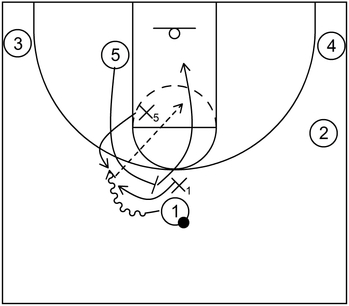
This is an example of a basic scoring play that uses the pocket pass near the left slot area. To begin, 1 dribbles towards the left slot via the on-ball screen set by 5.
Following that, 1 attempts to dribble towards the basket. However, as that occurs, X5 executes a soft hedge to limit dribble penetration while X1 fights over the top of the screen.
At the same time, 5 rolls to the basket and receives the ball from 1 via the pocket pass. Afterwards, 5 scores at the rim with a layup or dunk.
Example 2
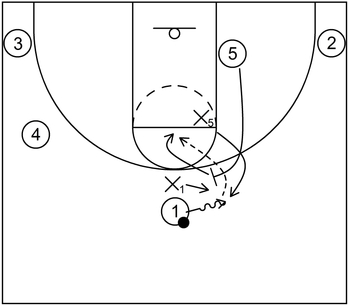
This is an example of a scoring play that uses the pocket pass near the right slot area. To start, 1 begins to dribble towards the right slot area via an on-ball screen set by 5.
As that occurs, X5 executes a hard hedge to prevent any dribble penetration while X1 begins to fight through the screen.
Next, to counter the hard hedge action, 5 executes a short roll to the high post area and receives the ball from 1 via the pocket pass.
Afterwards, 5 could take the mid-range jump shot or possibly drive to the basket and score at the rim with a layup or dunk.
Example 3
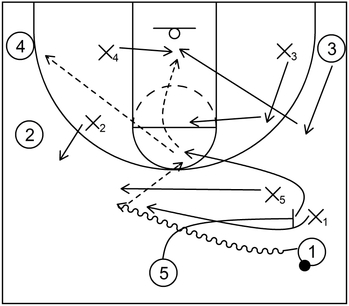
This is an example of a scoring play with multiple options that features the pocket pass within secondary break. To begin, 1 dribbles toward the middle of the court via the drag screen set by 5.
As that occurs, X1 and X5 execute a blitz against 1 which causes 1 to change the dribbling destination towards the left slot area as opposed to gaining dribble penetration down the middle.
At the same time, X2 implements denial defense so that 2 cannot easily receive the ball from 1.
Furthermore, as 1 dribbles toward the left slot, 3 lifts up to the right side wing area from the right side corner. Next, to counter the blitz action, 5 executes a short roll to the high post area and then receives the ball from 1.
After that, 5 could simply take the mid-range jump shot as the first scoring option. However, if X3 happens to slide over towards 5 to take away the potential uncontested mid-range shot, then 3 could cut to the basket, receive the ball from 5 and score at the rim as the second option.
Moreover, if 3 cuts to the basket but X4 slides into the lane to prevent a possible uncontested layup, then 4 could receive the ball from 5. Following that, 4 could take the three-point jump shot if that is open.
Related: Michigan Wolverines – Short Roll with Pocket Pass – YouTube
Example 4
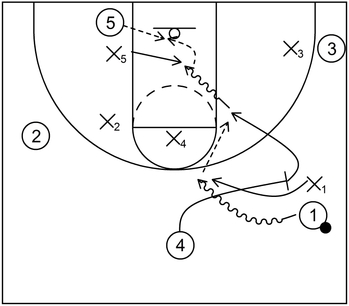
This is an example of a scoring play that utilizes the pocket pass within early offense. To start, 1 dribbles toward the top via the drag screen set by 5 and as that occurs, X1 fights through the screen to chase after 1.
At the same time, X4 executes drop coverage but in this instance, that drop coverage is lackadaisical because X4 is not at the proper angle to fully stop the potential roll action of 4.
Essentially, in this case, while 1 dribbles toward the top, X4 would have to backpedal into the lane so that if 4 received the ball via roll action, then X4 would be able to properly defend.
Nevertheless, 1 and 4 are able to take advantage of this particular defensive error by having 4 short roll slightly below the right side high post elbow area.
Following that, 4 receives the ball via the pocket pass by 1 and then 4 begins to dribble towards the basket to score at the rim with a layup or dunk.
Also, if X5 slides into the lane to give help defense, then 5 could cut to the rim from the dunker spot, receive the ball from 4, preferably via alley-oop action, and score at the rim with a layup or dunk.
Related: Golden State Warriors – Short Rolls, Pocket Passes and More – YouTube
Example 5
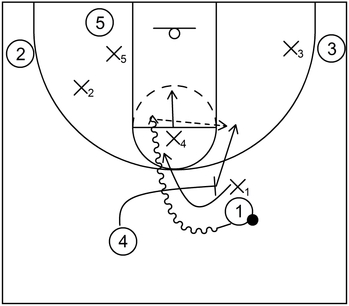
This is another example of a scoring play that uses the pocket pass within early offense and it is somewhat similar to the previous example but there is one minor difference, specifically with the drop coverage.
To begin, 1 dribbles towards the basket via the drag screen set by 4 and as that happens, X1 fights over the top of the screen to chase after 1.
At the same time, X4 executes drop coverage but in this instance, X4 backpedals towards the basket to further prevent the potential roll action of 4 while still containing the dribble penetration of 1.
However, 4 counters that defensive action by executing a short roll towards the right side high post elbow area. Following that, 4 receives the ball from 1 via a pocket pass and then, 4 takes the open mid-range jump shot.
Example 6
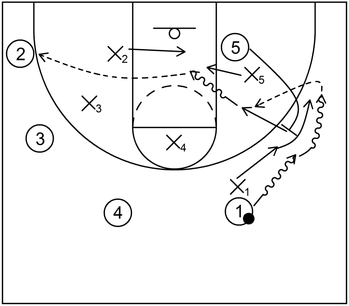
This is an example of a scoring play that uses the pocket pass based on a variation of the standard 4 out 1 in alignment.
To begin, 1 executes a dribble entry towards the right side wing while being guarded by X1. Next, 1 continues to dribble towards the baseline via a step-up screen set by 5 while X1 fights over the top of the screen to chase after 1.
At the same time, X5 stays back in the drop coverage to take away the possible roll action of 5. However, 5 counters that drop coverage by executing a short roll near the mid-post extended area.
Afterwards, 5 receives the ball from 1 via the pocket pass and then, 5 dribbles toward the basket while X5 attempts to defend.
Also, if X2 slides into the lane to provide help, then 2 could receive the ball from 5 via a kick pass. Following that, 2 could take the three-point shot if that is open.
Example 7
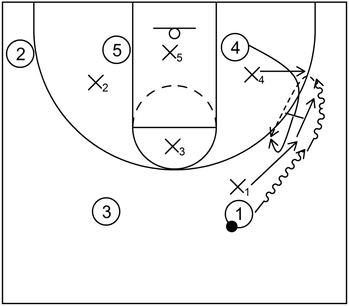
This is an example of a scoring play that implements the pocket pass derived from a variation of the 2 out 3 in formation.
To start, 1 executes a dribble entry towards the right side wing while X1 covers with solid man to man defense. After that, 1 attempts to dribble towards the baseline via a step-up screen set by 4 while X1 fights through the screen to chase after 1.
At the same time, X4 executes a soft hedge to limit any potential dribble penetration by 1. However, 4 counters that soft hedge tactic by popping behind the three-point arc near the right side wing. Next, 4 receives the ball from 1 and following that, 4 could take the three-point jump shot if that is open.
Related : Lonzo Ball – Pocket Pass/Bounce Pass – YouTube
Example 8
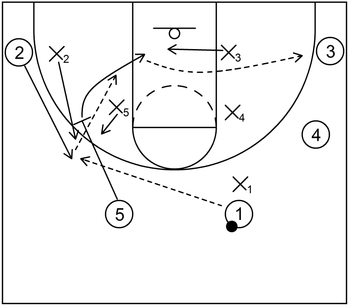
This is an example of a scoring play that utilizes the pocket pass via a variation of the standard 5 out alignment.
Also, in this instance, 2 is the offensive team’s best shooter so X2 as well as X5 are on high alert and do not want to give 2 an open jump shot.
To begin, 2 cuts toward the extended left slot area via the down screen set by 5. As that happens, X2 fights over the top of the screen to stay in front of 2 while X5 also stays near 2 to provide additional help if necessary.
However, 5 is able to quickly read the defense and as a result, 5 immediately rolls to the basket. Next, 5 receives the ball from 2 via the pocket pass and scores at the rim via a layup or dunk.
In addition to that, if X3 slides into the lane to give extra help defense, then 3 could receive the ball from 5 via a kick pass and take the open jump shot.
Related: Golden State Offense – Pin Down Screens and Pocket Pass Action – YouTube